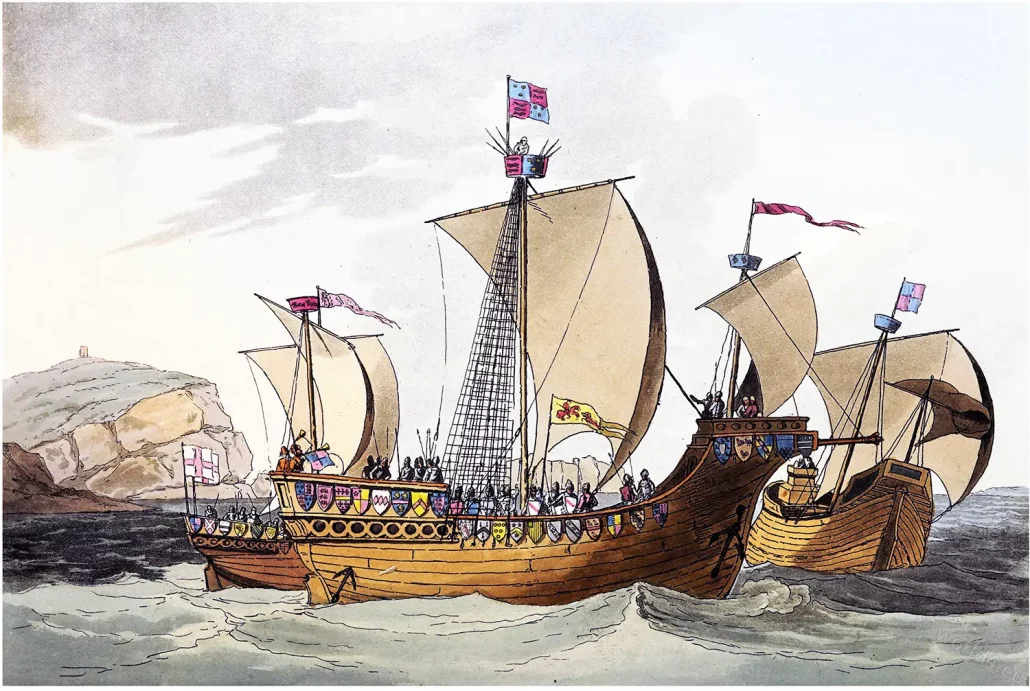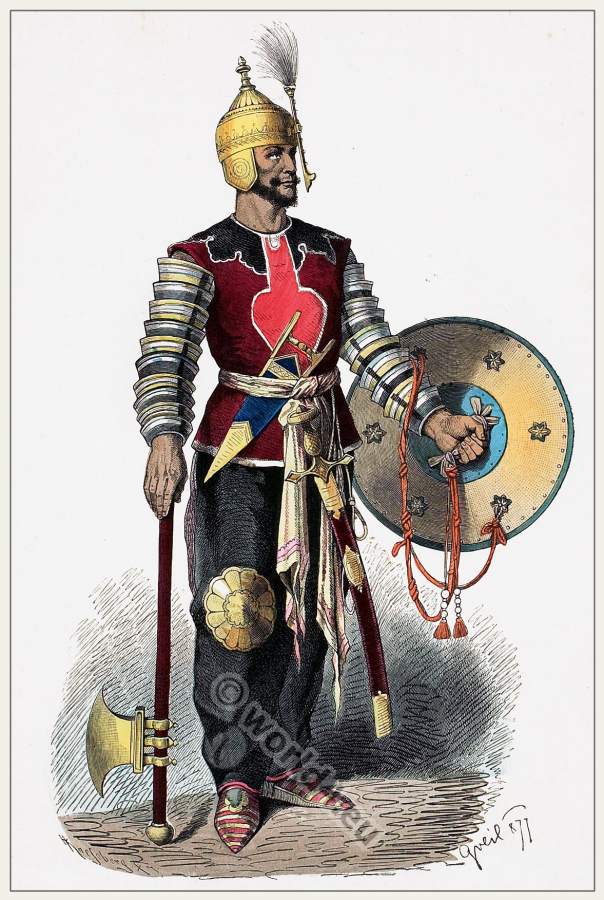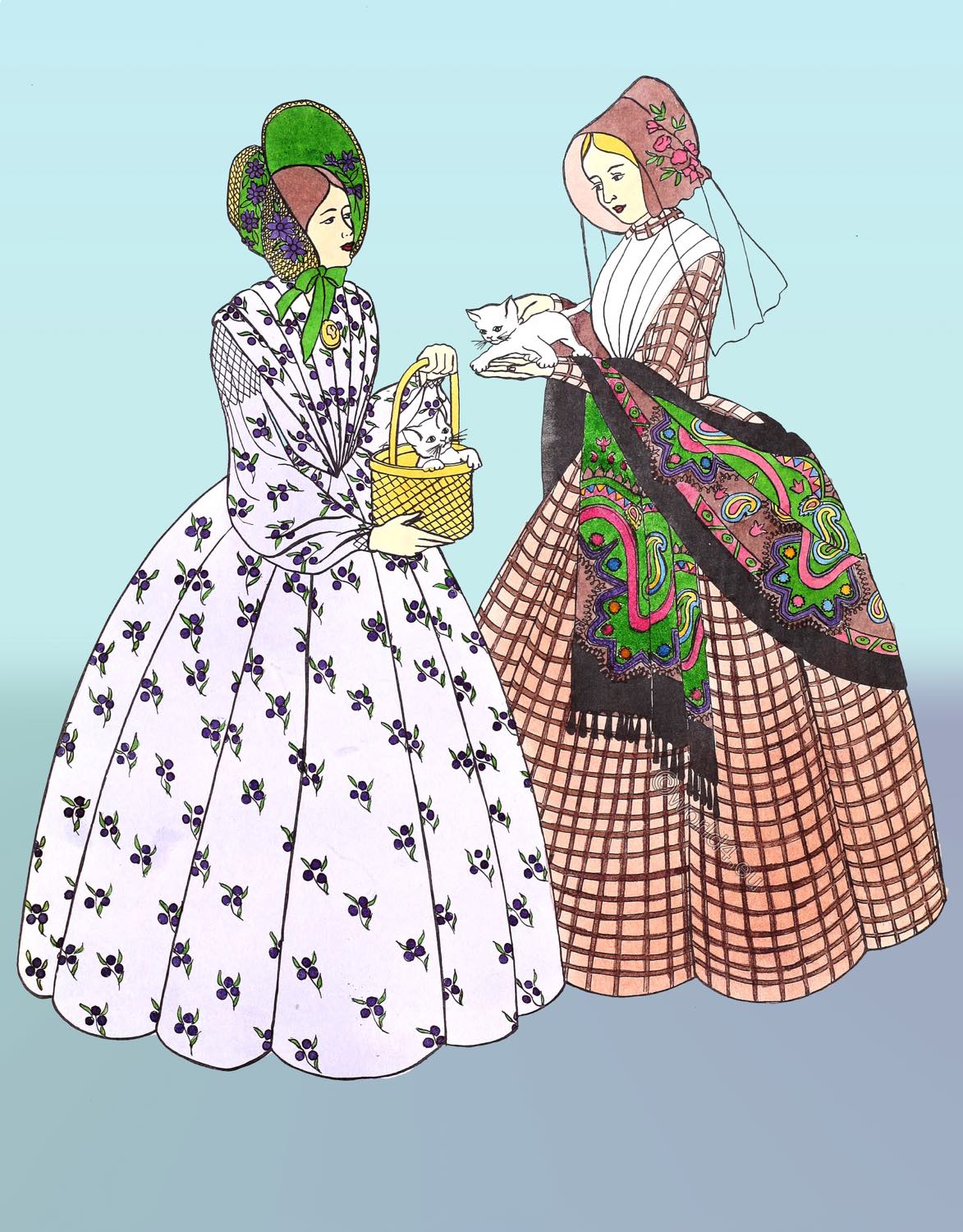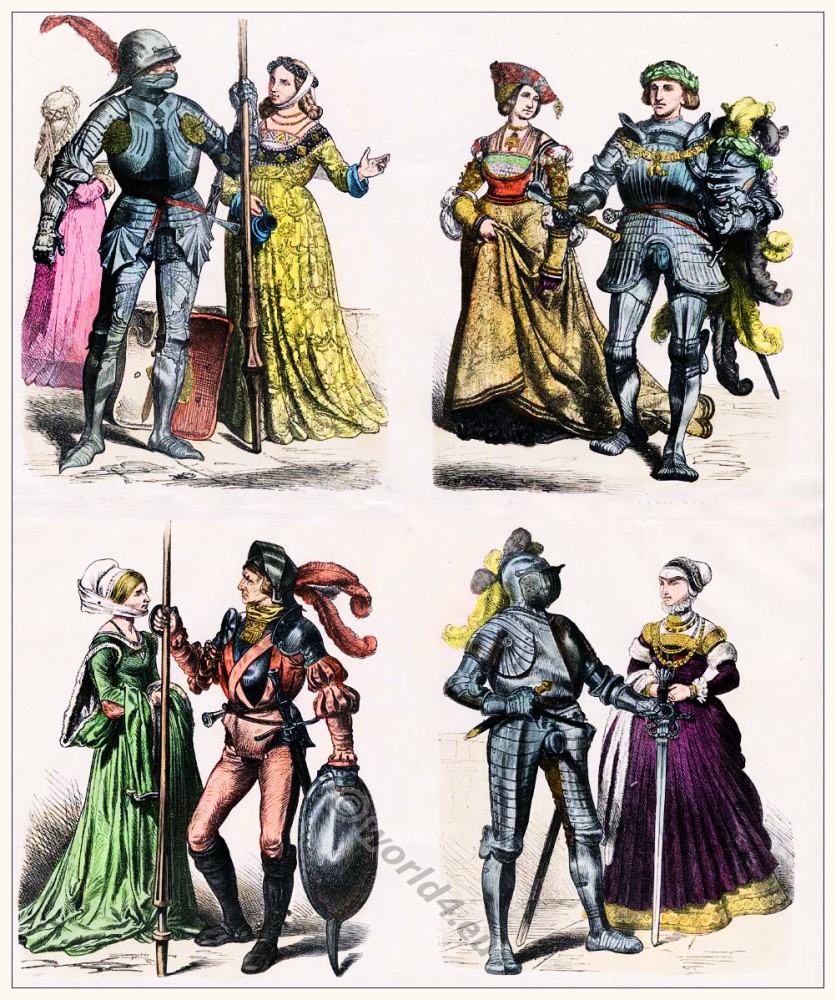SHIPS OF THE FOURTEENTH AND FIFTEENTH CENTURIES. FROM 1375 TO 1425.
by Charles Hamilton Smith.
From the inspection of the Plate, it will readily be perceived, that no improvement of moment had taken place, in the construction of shipping, from the times of the crusades, as represented in a former number, down to the period now under consideration.
In form, the hulls and lofty extremities remained essentially the same, and it is fair to presume, that, limited as experience in the true principles of naval architecture then was, the warriors (who in those days fought either hand to hand with their enemies, or with missiles of short ranges) derived considerable advantage from being placed on elevated platforms, in shape not unlike the turret-defences on land.
That this eminence of station added materially to the security of vessels, we may infer, from the frequent mention made in our early historians of Spanish ships being with greater difficulty assailed or captured, because their bulk was larger, and their castles loftier than those of the English.
The vessel in the back-ground with its stern visible, is of the reign of Richard II.; the after-part is considerably elevated; and on the prow we perceive a tower, besides the main mast, there is a smaller close to the stern.
The ship in front is a man of war (such as King Henry V. employed in his expeditions against France) furnished with three masts and sails, and having, from a lofty forecastle, a spar projecting for a bowsprit.
The poop is not quite so high as in anterior specimens, and below are perceivable what may be taken for a row of cabin windows, or round port-holes. From the main top, emblazoned with arms, is seen flying the royal standard, and within it, a quantity of darts ready to be flung at the enemy.
The sides of the ship are ornamented with a row of shields bearing the arms of the principal persons embarked. In the original illumination, these armorial bearings cannot be traced to any particular families, if we except a few within the vessel: we have therefore taken the liberty of suppressing them, and substituting the arms of some of the most distinguished characters in the French wars under King Henry V. or of persons known to have been attached to his household.
- Beginning from the after part of the ship, the first shield has modern France and England, as first quartered by Henry V.
- England, a border argent, for Edmund Holland, Earl of Kent; killed at the siege of Briaque. He was Lord Admiral of the Fleet.
- Gules, a fess between 6‘cross croslets or, for Richard, Earl of Warwick; distinguished for first entering the breach at Caen, taking Confront, Caudebec, and Mont St. Michel. He was rewarded by the King with the Earldom of Aumarle.
- Quarterly gules and or, in the first a mullet of 5 points argent, for Richard de Vere, Earl of Oxford; he fought in the King’s battalion, at Azincourt.
- Argent, three fusils in fess gules, for Thomas de Montacute, Earl of Salisbury; illustrious for many great actions, and killed at the siege of Orleans, in the reign of Henry VI.
- Azure, a fess between three leopards heads or, for Michael de la Pole, Earl of Suffolk. Both father and son perished in the wars, the elder dying at the siege of Harfleur, and his son in the battle of Azincourt.
- Or, a chevron gules, a crescent for difference; for Hugh Stafford, Lord Bourchier, who commanded a corps of troops in the army; and fought the action of Corbie.
- England within a border of France; for John Holland, Earl of Huntington, (afterwards Duke of Exeter) he was Lord Admiral after the death of the Earl of Kent.
- Ermine a lion rampant gules, within a border engrailed sable besantée;for Sir John Cornwall, Lord Fanhope, distinguished at Azincourt; where he took the Earl of Vendome prisoner.
- Argent, a chevron between three birds legs couped, sable’, forRobert Chaumberleyn, esquire to the king.
- Or, 6 annulets sable, 3, 2 and 1, for Sir Hugh Lowther, present at Azincourt. He was ancestor to the present Earls of Lonsdale.
- Sable, a chevron or, guttee de sang, between three cinquefoils ermine, for John Wodehouse, Esq., gentle man of the privy chamber of Henry IV. conspicuous at Azincourt. The present Lord Wodehouse is descended from him. He bears under his arms the word Azincourt.
- Paly of 8, or and gules, a canton vert, for Peter Basset, Esq., chamberleyn to the king.
- Argent, on a bend engrailed sable, three mullets of the field, for- Entwisle, Esq.,who inconsequence of his gallant behaviour at Azincourt, obtained for crest, handcouped in fess, holding a fleur de lys in pale with the words, “par ce signe a Azincourt.”
- Sable, three walnut leaves or, between two bendlets argent, for Richard Waller, of Groombridge, Esq., who, at the battle of Azincourt, captured the Duke of Orleans.
- Argent, a fess gules, between three parrots proper, gorged, with collars of the second, for Sir John Lumley, Baron Lumley, who was slain with the Duke of Clarence, at the battle of Baugie.
- Quarterly, per pale, dovetail gules and or, for John Bromley, Esq., ancestor of the present Lords Montfort.
- Argent, a bend between six martlets sable, for Sir Hugh Luttrell.
- Quarterly first and fourth, azure three pelicans vulning themselves or; second and third gules, 2 pieces of belts erect in pale argent, with buckles in chief, for Sir John Pelham, distinguished in the wars of Henry V.
- Azure, an inescutcheon within an orle of martlets argent, for Sir Thomas Erpingham, marshal of the army at Azincourt.
- Argent, three cocks gules, armed crested and jolloped or, for David Gamm, the valiant Welsh captain, knighted while dying during the battle of Azincourt.
- Quarterly or and azure, over all, on a bend gules, 3 scallop-shells argent, for Sir John Fastolfe.
- Azure, three chevrons braced in base or, a chief of the last, for Henry Lord Fitz-Hugh.
- Sable, two bars argent, in chief 3 plates; for Walter, Lord Hungerford, Steward of the Household to King Henry V.
The distance represents the Isle of Wight, with the Needles and the Hampshire shore.
AUTHORITIES.
The ship with the stern visible, from an illuminated MS. in the Cotton library B. M., Domitian, A. 17. The ship in front from a MS. Froissart, illuminated early in the 15th century, in the Harleian Collection, B. M., marked 4379. The arms from different heraldic works.
Source: Selections of the ancient costume of Great Britain and Ireland from the seventh to the sixteenth century, by Charles Hamilton Smith. London: Colnaghi, 1814.







